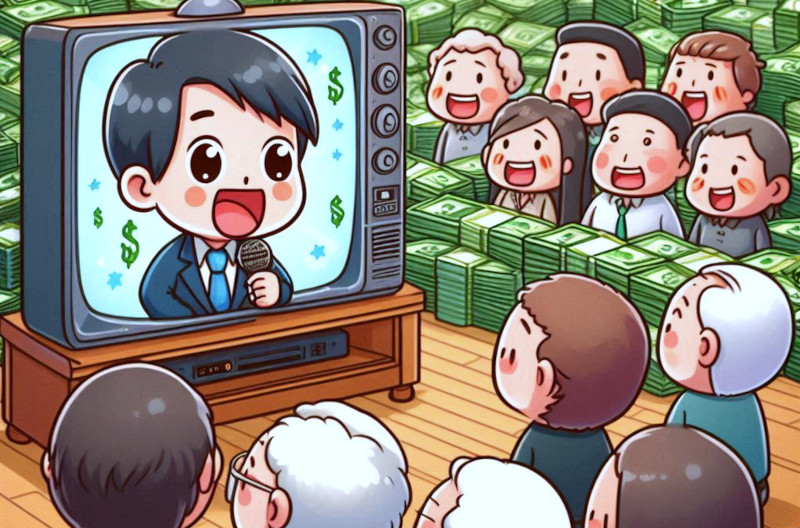Inflationland: A Tale of Rising Prices
Once upon a time in the whimsical country of Inflationland, there existed a central bank with an unmatched sense of duty. This central bank, known as the Bureau of Eternal Printing (BEP), had a rather peculiar mission: to make sure that every citizen had more and more pieces of paper called 'money'. The folks at the BEP were big believers in the magic of abundance—if a little is good, then a lot must be better!
The Great Money Printing Machine

At the heart of the BEP was a giant money printing machine named 'Inflatron 3000'. Inflatron wasn't your average machine; it had personality, flair, and a relentless appetite for printing money. It chugged along day and night, spewing out fresh, crisp banknotes like a dragon breathing fire, ensuring that there was always more money to go around.
The citizens of Inflationland, seeing all this new money floating about, felt quite rich. The government announced with great fanfare that incomes were rising across the board. Everyone was getting salary raises—10%, 20%, even 30%! The citizens cheered, thinking they were becoming wealthier every day.
But there was a twist in the tale, one that the good folks of Inflationland failed to notice at first. As more and more money flooded the market, the value of each individual note began to shrink - a classic case of inflation. The streets might have been buzzing with excitement, but under the surface, an entirely different story was quietly taking shape.
The Wealth Transfer
The corporate titans and their cronies in the financial sector were quick to identify the golden opportunity presented by Inflationland's massive money printing. They borrowed heaps of money, bought up assets like real estate, commodities and stocks. As the days passed, these savvy asset owners watched with glee as the value of their investments soared. Meanwhile, their mortgages seemed to shrink in comparison. The more inflation rose, the smaller their debts felt. They were kicking back with satisfaction, like they had discovered a bottomless treasure chest, watching their fortunes rise and their debts evaporate with every tick of inflation.
Cautious savers, on the other hand, were not so fortunate. They had diligently tucked away their money in banks, trusting it would be safely stored for a rainy day. But inflation was like a sneaky mouse nibbling away at their cheese. Every month, their savings bought a little less, and the interest they earned barely made a difference. The banks praised the virtues of "saving for the future," but to the savers, it felt like they'd been given a faulty map, leading them straight into quicksand.
Wage earners, too, were caught in the crossfire. They noticed that while their paychecks were indeed getting larger, everything else was getting even more expensive. The price of bread, rent, and even a cup of coffee at Café Exorbitant seemed to be going up faster than a hot air balloon at a festival. Buying a home became a distant fantasy as property prices soared, leaving them no choice but to rent from the very asset owners who were cashing in on inflation.
The Government's Spending Spree
As if this wasn't enough, the government of Inflationland decided to get in on the action. Seeing all the fresh, new money printed by the BEP, they figured, “Why not borrow some and have a bit of fun?” And borrow they did—truckloads of cash, with promises to pay back "someday, maybe."

Armed with their newly borrowed funds, the government launched a series of grand spending initiatives with great pomp and circumstance. They announced "The Festival of Fortunes," a week-long celebration where entrance to all museums was free. The highlight of this festival was the guided tours of the Inflatron 3000 machine, the very device responsible for creating the seemingly endless supply of new money. Citizens flocked to see this marvel of modern economics, delighting in the theatrics of smoke effects and the rhythmic clinking of imaginary coins as they witnessed their economy "growing" before their eyes.
They also kicked off a slew of new projects: "Bridges to Nowhere," a massive infrastructure project involving building bridges to tiny, uninhabited islands with no resources or reason to visit. Then there was the "Solar Panels for Shadows" program, a bold initiative to install solar panels in the shadiest parts of the forest, in an effort to prove that green energy works anywhere, even where the sun doesn't shine. And let's not forget the innovative "National Cloud Appreciation Program," which employed thousands of people to gaze at the sky and report on the fluffiness of clouds. This project was said to boost national morale and provide a much-needed distraction from rising prices and shrinking savings.
The citizens, dazzled by the shiny new projects and the apparent generosity of their government, cheered wildly. They thought their leaders were wise stewards of the economy, providing jobs, entertainment, and infrastructure.
Little did they know that these projects, far from being sound investments, were just another way to inflate the money supply even more. The more money that was printed and borrowed, the less value it had. With every bridge to nowhere and solar panel in the shade, the purchasing power of their salaries and savings dwindled further and further, like a snowman in July.
The Currency Conundrum
Amidst all this excitement, a puzzling problem began to emerge: the currency of Inflationland, once strong and robust, was now taking a nosedive. As the value of their money continued to drop, importing goods from other countries became more and more expensive. The citizens, who had once enjoyed vacations abroad and imported luxuries, found that these were now beyond their reach. A simple holiday to Sunny Beachland now cost an arm, a leg, and the promise of their firstborn child.
Naturally, the BEP was quick to assure everyone that they had no idea why this was happening. It was a complete mystery to them! They suggested perhaps it was sunspots, or maybe even the alignment of the planets. They had their best people on it, they said, though they weren't quite sure who those people were or what they were doing.
Meanwhile, the government's top economists took to the airwaves to calm the panicking populace. "A strong currency is an outdated concept," they proclaimed, "a relic of a bygone era." According to them, the current collapsed value was the new normal — a desired natural evolution in a dynamic, modern economy. They went on to gleefully declare “A weak currency is a great benefit. Think of it as a country-wide clearance event! Foreigners will come rushing in to buy everything at a fraction of the price. It's like we're the ultimate discount destination. And who doesn't love a good deal?”
The citizens weren't entirely convinced. They had grown tired of paying extra for everything from imported bananas to bicycles. But the economists were quick to respond, “Higher prices for us mean even better deals for them! It's a small sacrifice to make for turning Inflationland into the hottest destination for bargain hunters everywhere."
The Mystical Inflation Calculation
Over at the Government Statistical Bureau (GSB), another curious phenomenon was unfolding. The GSB, tasked with calculating the official inflation rate, had developed its very own special formula — a formula so mysterious and complex that it could only be understood by a select few, and those few were sworn to secrecy.
One of the bureau's cleverest tricks was to redefine the "basket of goods" used to measure inflation. The GSB decided that the cost of housing, one of the most significant expenses for ordinary citizens, would no longer be included in the inflation calculation. "Why let something like skyrocketing house prices spoil the party?" they reasoned. Instead, they filled the basket with items like flip-flops in winter, rubber duckies, and gourmet cat food, which conveniently showed little to no price change.
But it didn't stop there. The bureau had a secret weapon called "hedonic adjustment." If the price of something went up but the quality supposedly improved (even if the improvement was invisible to the naked eye), the increase wasn't counted as inflation. "Why, this year's rubber ducky squeaks 10% louder than last year's model!" they'd say, reducing the inflation rate accordingly.
As a result, the official inflation figures released by the GSB were remarkably low and incredibly stable, no matter how much money the BEP printed. According to these figures, the citizens of Inflationland had nothing to worry about. Inflation was barely a blip on the radar!

The Grand Illusion and Citizen Misdirection
So, how did the government and the BEP manage to keep everyone so blissfully unaware of what was really going on? They employed a variety of smoke and mirrors, backed by a team of economists who were experts in "economic doublespeak." These economists went on television to explain that inflation was "transitory" or "a sign of a booming economy," or that it was caused by "external factors" beyond anyone's control.
They threw around terms like "quantitative easing," "fiscal stimulus," and "monetary policy" like confetti at a parade, leaving most citizens utterly baffled. After all, if the experts said everything was fine, who were they to argue?
Every time a new spending spree was announced, the government reassured the populace that these were wise investments for the future, conveniently sidestepping the plummeting purchasing power of their money. So, the citizens cheered, toasted with overpriced wine, and continued to believe that prosperity was just around the corner, happily unaware that they were footing the bill for their own illusion of wealth.
The Moral of the Story
And so, the tale of Inflationland continues, with the BEP merrily printing money, the government borrowing and spending with reckless abandon, the debt holders and asset owners growing richer, and the average citizen struggling to keep up with rising prices. The moral of this humorous yet cautionary tale? In the world of inflation, not everything that glitters is gold.
So next time you see your paycheck or price of your house going up, don't be too quick to pop the champagne. Instead, take a moment to consider what that money is actually worth. And remember that in Inflationland, things are rarely as they seem.